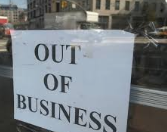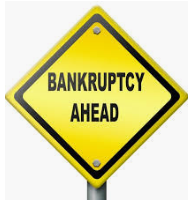4.43 Million Americans File Initial Jobless Claims… The additional jobless claims bring the five-week total to more than 26 million.
What it means – With the more than four million people who were unemployed before the economic shutdown, we’re now at about 30 million unemployed, or 20% of the U.S. workforce.
Protecting the vulnerable population from Covid-19 is prudent. However, many population segments are asking “At what cost?”
And it’s not just restaurant workers and hairdressers. Office workers are now feeling the heat as wide swaths of American businesses deal with falling revenue and reduced access to credit. If you divide the number of jobs lost over the last week by the number of cases reported in the US, it is 565 jobs lost for each person contracting the virus.

Every day that goes by is another day that many companies must sacrifice workers to survive. How can the national economy rebound quickly, especially when governors and mayors are, rightly, discussing a staged reopening? High unemployment has delayed affects including missed payments, falling consumption, and falling asset prices, such as cars and homes. Low or no income equals low or no consumer demand.
March New Home Sales Down 15.4%, Existing Home Sales Down 8.5%… The steep drops were expected. The trend should continue in April.
What it means – We can’t tour most homes in person. Lenders are reluctant to lend when they don’t know who will be employed when this is over or who will be looking for a job.
It’s a wonder that both new and existing home sales weren’t down more in March. If you’re looking for worse news in the industry, just wait 30 days. Chances are the reports for April will be uglier than March.
There was a bit of optimism. The median new home price increased 3.5% over last year to $321,400. That might not hold up with high unemployment numbers. At least sellers are starting from a higher point. Fewer sales means inventory is rising. Qualified buyers will have more choices. Sellers have lost their negotiating position.
March Durable Goods Orders Down 14.4%… Led lower by civilian aircraft, orders for goods lasting more than three years fell by the most since 2014.
What it means – Everyone expected bad news, so this wasn’t a surprise. But there was an odd number in the report. Non-defense capital spending excluding aircraft rose 0.1%. The measure isn’t expected to hold up in April, the first full month of the economic shut down. It was nice to see that not everything was in a deep freeze in March.
Congress Passes $480 Billion Relief Package… Congress added $380 billion to the small business relief fund, plus $75 billion for hospitals and $25 billion for testing.
What it means – If the goal is to make businesses whole during the downturn at the expense of the national taxpayer, it’s still not enough. The $700 billion for small businesses will be a huge benefit. We’re getting stories from the margin that are frustrating such as large hotel chains and universities getting loans. Though some didn’t even apply and have declined the cash. The issue remains that much of the funds must be spent on payroll. In a knowledge-based economy, this cuts out many small businesses that have few employees but significant sales. They get no relief and will find it hard to survive.
No Extras for Cities and States, McConnell Suggests They Use Bankruptcy… The CARES Act included $150 billion for states and large cities, but those entities wanted more bailout funds to cover missing tax revenue.
What it means – Money is fungible. You can move it from pocket to pocket and not tell the difference. Senate Majority Leader Mitch  McConnell said it would be a mistake to send bailout funds for the coronavirus to cities and states that could then use it to paper over their mismanaged pensions and other fiscal problems they had before all this started. To top it off, McConnell said he’d favor the states using bankruptcy to address their issues. That didn’t sit well with governors around the nation, and it’s not possible in the bankruptcy code today. But you never know, things change.
McConnell said it would be a mistake to send bailout funds for the coronavirus to cities and states that could then use it to paper over their mismanaged pensions and other fiscal problems they had before all this started. To top it off, McConnell said he’d favor the states using bankruptcy to address their issues. That didn’t sit well with governors around the nation, and it’s not possible in the bankruptcy code today. But you never know, things change.
Detroit stiffed bondholders and pledged assets it didn’t clearly own to get out of bankruptcy. There could be some fancy financial moves ahead where states use bankruptcy to crush bondholders while modestly adjusting payouts. It’s more likely that cities and states make another run at Congress later this summer, demanding cash… and they get it.
In Washington State, the pension fund has been well managed and is near full funding. How many residents want to pay more federal tax to bail out Illinois, California or New York pensions? Those are just the biggies. Many more are ready to join the clamor for federal bail-out.
Oil Futures Go Negative I May, Close Monday at -$38… Oil for delivery in May closed below zero for the first time in history, then moved slightly above zero on Tuesday, when the contract expired.
What it means – It’s not as crazy as it sounds. The contracts expiring on Tuesday required the holder to take physical delivery of 1,000  barrels of oil per contract. With demand down 30% to 40%, and production still high, there isn’t much storage left. Some contract holders chose to pay others to take their oil rather than have to deal with the issue. There are more than 130 million barrels of oil in storage on very large crude carriers (VLCCs) offshore. People are looking for any place to stash the stuff and wait for a better time to sell. With the global slow down, the wait may be quite long.
barrels of oil per contract. With demand down 30% to 40%, and production still high, there isn’t much storage left. Some contract holders chose to pay others to take their oil rather than have to deal with the issue. There are more than 130 million barrels of oil in storage on very large crude carriers (VLCCs) offshore. People are looking for any place to stash the stuff and wait for a better time to sell. With the global slow down, the wait may be quite long.
Gilead Anti-Retroviral Drug Shows Lackluster Results in Covid-19 Test… In a Chinese study that included 158 patients on remdesivir and 79 not on the drug, the group receiving remdesivir had a 13.9% mortality rate, while the control group had a 12.8% mortality rate. The Chinese ended the study early because of the lack of efficacy. Gilead took exception.
The company notes that the drug is an anti-retroviral. To be effective it must be administered in the early stages of the disease. In the Chinese study, the drug was given to patients with moderate and severe cases of Covid-19.
When it comes to a therapeutic, we’re still looking, which is one more reason business will be slow to open. If Wuhan is the example of a return to normal, consumers will be slow to congregate in public places. That includes malls and restaurants.

